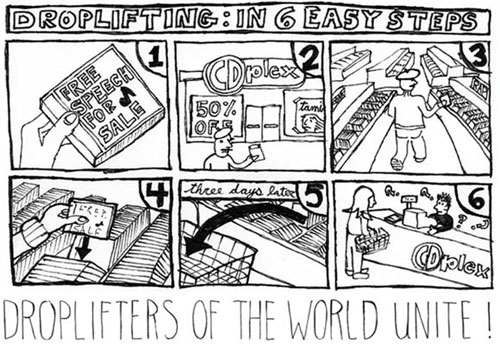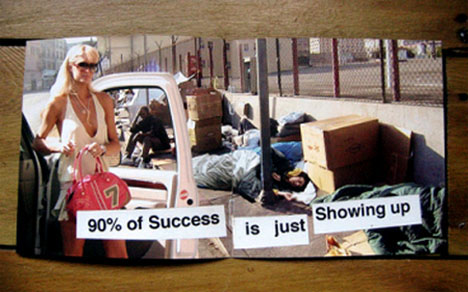(Check out our complete collection of Subversive Marketing and Culture Jamming.)
Shopdropping was probably the last kind of giving on most people’s minds as they shopped during the holiday season. Shopdropping, also known as droplifting, is the incredible act of reverse shoplifting: going into stores and putting things onto the shelves. Banksy is probably the best known shopdropper, famous for putting out his own subvertised versions of Paris Hilton’s CDs and hanging his subversive art in galleries. Here is your beginner’s guide to the art (or science).

Above: great ‘beginner’s guide to shopdropping’ including Banksy
Shopdroppers have their own reasons for doing what they do. Some are social and political culture jammers who want to raising awareness about consumerism or adding warnings to dangerous products. Others seek to promote their own product, such as an album left in a record store. Still others do it for their own amusement and artistic fulfillment without expectations of any kind of return.
Some shopdrop projects are individual endeavors while others are the work of highly organized groups, such as the Droplift Project. The Droplift Project takes found sound and turns it into an audio collage to create “new art, social commentary, parody and contemporary criticism.” Ryan Watkins-Hughes of ShopDropping.net adds his own labels to commercial products simply as a form of self-expression.
It might not surprise you to learn that reactions to shopdropping or droplifting vary as much as approaches to it and reasons for doing it. Some people find it harmless and amusing while others find it shocking and disturbing. Shopdroppers who are caught are variously freed by confused police or held on charges related to destruction of property or even fraud. Reactions, criticisms or other shopdropping thoughts?
Thanks to Kim for the tip! Got a tip? Send it here.

